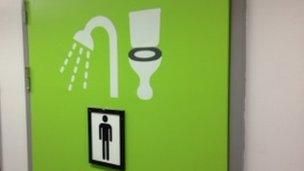Getting it right for dementia patients
- Published
- comments
Bridget Fordham
Much has been made of the poor care the elderly can sometimes experience at the hands of hospitals in the NHS.
Some of the most depressing cases involve dementia patients - as shown in the dossier of "appalling" cases highlighted by the Patients Association a few weeks ago.
Last week a report by monitoring body Dr Foster gave an insight into the difficulties hospitals are facing with overcrowding which makes providing the right care for the frail and elderly more difficult.
But that doesn't mean there aren't places getting it right - as I found out when I visited the world-renowned Guy's and St Thomas's Trust in the heart of London.
The trust has been giving special consideration to the care it provides to dementia patients for some time.
Part of this involves providing specialist dementia training to staff, which has been happening since 2009.
At first it was given to nurses and other key staff such as speech therapists and dieticians, but it has now been rolled out to the entire workforce from doctors to porters.
'Big difference'
Bridget Fordham, the trust's clinical nurse specialist for dementia, told me: "Our staff said that of all the patients they dealt with they were the most unsure about those with dementia.
"They just did not have the confidence or skills to deal with them. Dementia patients can get very agitated. Delirium is a big problem.
"So we started doing some training to help. Staff say it has made a big difference and helped them in the way they care for patients."
But the trust has also sought to make changes to the physical environment to help dementia patients.
In the three elderly care wards at St Thomas's Hospital doors to toilets and washrooms have been colour-coded with bays to give patients visual prompts in finding their way round.

Doors to bathrooms are colour-coded with bays so dementia patients can find their way round more easily
Padded flooring has also been laid to help soften falls, which are more likely among dementia patients.
A number of other measures have been introduced trust-wide.
These include a print of a forget-me-not which is placed above the bed of all dementia patients to alert staff to their condition. Dementia patients are also given blue wristbands to wear.
This has proved particularly useful if patients have wandered away from their wards, as Ms Fordham explains.
"We obviously don't want to lock patients in and people with dementia can go wandering so what this does is tell staff that this patient has dementia and should not be out on their own.
"We have had security staff finding patients and because they have had the dementia training they understand the situation and know how to approach them."
Red trays and beakers are also used to signify which patients need help with nutrition.
Nurses on the elderly care wards believe the aids have been a big help.
Deputy charge nurse Jim Domingo says: "They are really useful. If you are coming back from some time off or when there is agency staff working it just makes sure we know straight away who needs what."
Patients and their carers appreciate these measures too. Christine Nethercott, 64, from nearby Bermondsey, has been a regular visitor to St Thomas's over the past five weeks as her mother, Eleanor, has been recuperating from an infection.
While she has been in, Eleanor has had dementia diagnosed.
"It's really reassuring to know staff will be aware of my mother's condition and looking our for her when I am not here," says Christine.
"I must say the care she has received has been wonderful."